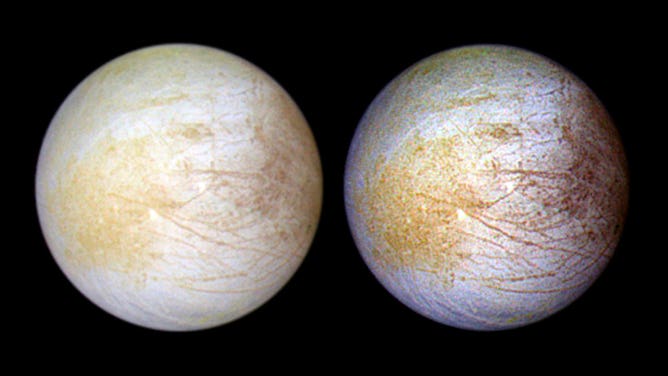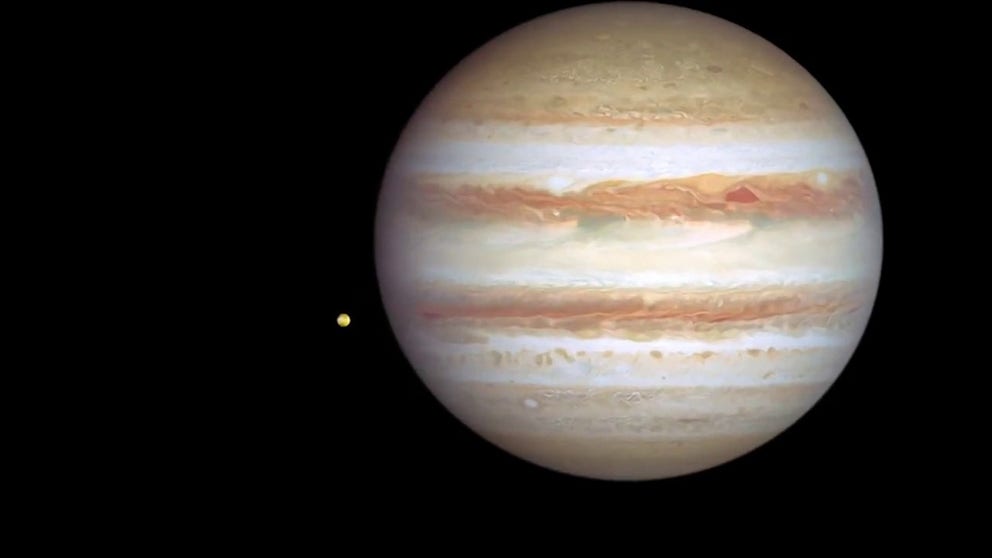NASA sending probe to Jupiter’s Europa in search for elements of life among suspected waterworld
A SpaceX Falcon Heavy rocket will launch NASA’s Europa Clipper spacecraft from Florida in October. Scientists believe Jupiter’s moon Europa has properties that could support life, including a global ocean lying underneath its icy crust.
Hubble Space Telescope tracks Jupiter's changing storms
FILE VIDEO: The giant planet Jupiter, in all its banded glory, takes the spotlight in these new images from NASA's Hubble Space Telescope that capture both sides of the planet. (Video credit: NASA's Goddard Space Flight Center, Paul Morris/Aaron E. Lepsch | Music credit: "From Seedling to Something" by Matt Norman)
Europa Clipper, a NASA spacecraft named after the Jupiter moon it will study, could launch as soon as mid-October, beginning the journey to reveal if this suspected waterworld might support life.
With 95 moons, all with unique geology and features, the gas-giant planet Jupiter has the most satellites of any planet in our solar system. Scientists have honed in on Europa as among the most interesting moons in Jupiter's orbit. Research and observations by other spacecraft suggest it's highly likely Europa hosts a global liquid ocean under its icy crust that may hold the elements needed to support life.
NASA'S HUBBLE TELESCOPE CAPTURES JUPITER'S GIANT STORMS SWIRLING
Most recently, scientists with NASA's Juno mission, orbiting Jupiter, found that Europa produces much more oxygen than some previous estimates. According to the study published in Nature Astronomy, the oxygen coming off the moon's surface is about 1,000 tons every 24 hours, enough to keep a million humans breathing for a day.
NASA selected the SpaceX Falcon Heavy rocket to launch the Europa Clipper spacecraft from NASA's Kennedy Space Center in Florida to the Jovian moon no earlier than Oct. 10. SpaceX and NASA will announce a launch date later this month.

This photograph of the Jovian moon Europa was taken in June 1997 at a range of 776,700 miles by NASA's Galileo spacecraft.
(NASA)
The spacecraft has a suite of nine science instruments, including cameras and ice-penetrating radar, to help look beneath Europa's hard exterior and see if the world could have the elements to support life. According to NASA, there is strong evidence Europa's crust may contain a volume of water twice the volume of Earth's oceans combined.
BOEING STARLINER SET TO DEPART FROM SPACE STATION WITHOUT ASTRONAUTS, ENDING TUMULTUOUS FLIGHT
However, the launch date could change due to an ongoing investigation into a possible problem with radiation exposure for spacecraft hardware.

Engineers and technicians install a 10-foot high-gain antenna on NASA's Europa Clipper spacecraft on Aug. 14, 2023. The orbiter is being assembled in the High Bay 1 clean room of the Spacecraft Assembly Facility at the agency's Jet Propulsion Laboratory (JPL). Europa Clipper will need the huge antenna to transmit data hundreds of millions of miles back to Earth.
(NASA)
Radiation is one risk of flying in deep space, especially within the Jupiter system. Europa Clipper mission managers recently learned of a potential flaw in some of the spacecraft's parts that might not withstand the intense radiation of the Jovian system.
Teams at NASA’s Jet Propulsion Laboratory in California, Johns Hopkins Applied Physics Laboratory (APL), and NASA's Goddard Space Flight Center in Maryland conducted testing to determine whether these parts would delay the mission.
NASA said an analysis of the testing "suggests the transistors can support the baseline mission."
On Sept. 9, NASA will conduct a final review to determine if the spacecraft can proceed to launch.
